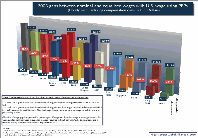
- © The Jus Semper Global Alliance
In this way, equal PPP compensation expresses the hourly U.S. dollar nominal rate required in a given country, in terms of purchasing power, in order to equally compensate local workers as equivalent U.S. workers are compensated for equal work rendered. Thus, this PPP compensation represents the real manufacturing wage required in each country to be at a par with the real manufacturing wage's purchasing power in the U.S.
An extremely Unfair System Given the fact that the purchasing power of equivalent manufacturing workers in most emerging economies is dramatically lower than that of their counterparts in the U.S., the resulting wage gaps are important evidence illustrating the huge disparity and unfairness of the global market system. Both domestic governments in the South and their partners in the North enforce an extremely cheap labour system. Indeed, the first reason why global corporations set-up manufacturing operations in the South, is because they are able to exploit workers by paying hunger wages vis-à-vis what they pay in the North for equivalent work, which in both cases is utilized to produce products and services that are marketed in global markets at global prices. The exploitation of enforced cheap labour costs, to be sure, is the major contributor to the increase of productivity and shareholder value among multinational corporations. Thus, these wage gaps expose a system of conscious and strategic exploitation of workers in the South. In this way, we contend that there is no other reason for materially compensating southern workers, for equal work rendered, at a dramatically lower standard of living than their northern counterparts, but for the pursuit of increased shareholder value in the North's global corporations and the monetary benefit of the South's domestic oligarchies. Although PPPs are only a cost of living assessment and not an exact measure, they eliminate the argument of lower costs of living for the enormous differences in wages. In sum, there are no economic or business justifications for this situation except the sheer greed of today's global Darwinian capitalism. Indeed, a key feature of the current system is that the higher the wage gap in a Southern economy, the farther away it is from the exercise of true democracy, for in a real democratic ethos the current system of global exploitation would not have the least opportunity.. The base data and sources used to produce the charts can be downloaded by clicking here (updated to 2009).
|



 and the OECD to their hourly nominal manufacturing wages. PPPs reflect the currency units required in a given currency to buy the same goods and services that can be purchased in the base country with one currency unit. The PPPs are in effect an estimate of the cost of living in each economy. Thus, a living wage is the hourly wage -above or below its nominal wage- necessary to provide a material standard of living equivalent to that in the benchmark, based on the PPPs reported for a specific year for each country. This analysis uses the U.S. and the U.S. dollar as the benchmark for a living wage. All nominal and PPP wages in all other countries are expressed in U.S. dollars as well.
and the OECD to their hourly nominal manufacturing wages. PPPs reflect the currency units required in a given currency to buy the same goods and services that can be purchased in the base country with one currency unit. The PPPs are in effect an estimate of the cost of living in each economy. Thus, a living wage is the hourly wage -above or below its nominal wage- necessary to provide a material standard of living equivalent to that in the benchmark, based on the PPPs reported for a specific year for each country. This analysis uses the U.S. and the U.S. dollar as the benchmark for a living wage. All nominal and PPP wages in all other countries are expressed in U.S. dollars as well.

